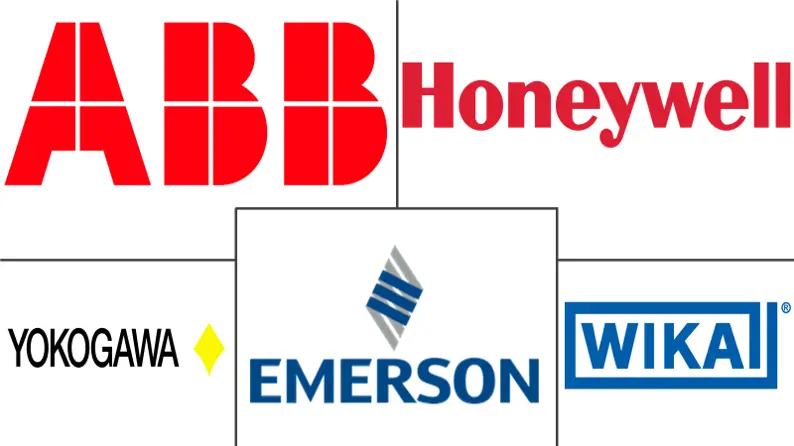Pressure Transmitter And Transducer Market Size and Share
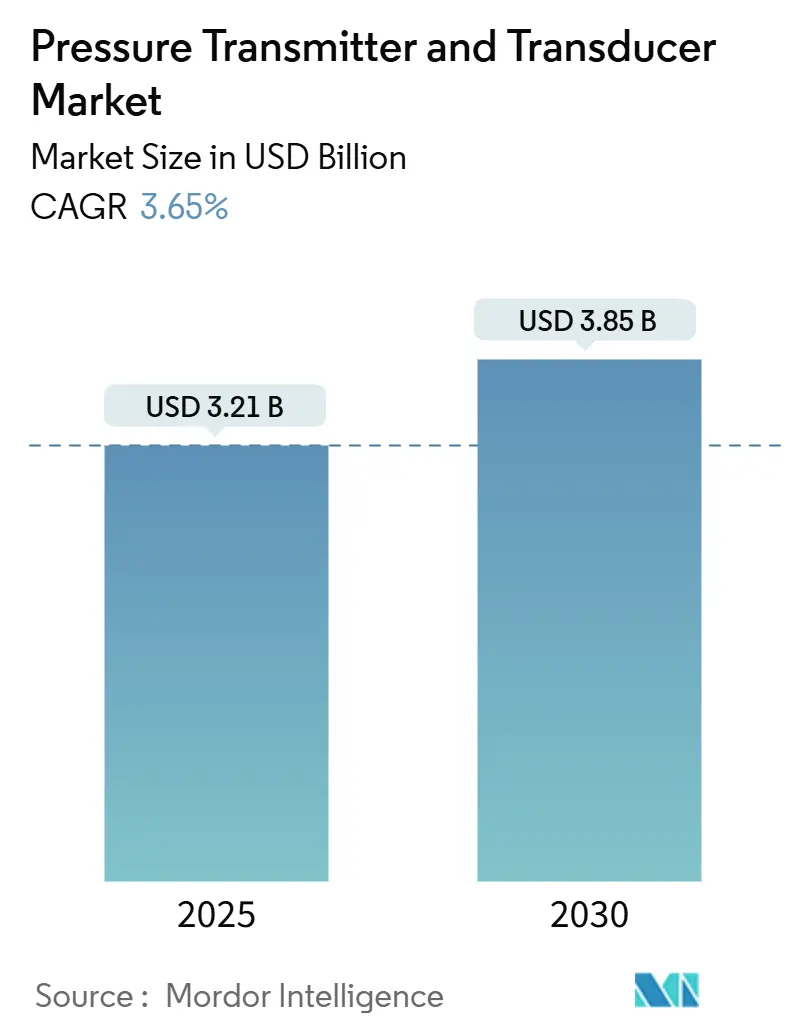
Pressure Transmitter And Transducer Market Analysis by Mordor Intelligence
The pressure transmitter and transducer market size is estimated at USD 3.21 billion in 2025 and is forecast to reach USD 3.85 billion by 2030, expanding at a 3.65% CAGR. Growth rests on rising demand for smart instrumentation in refineries, deeper offshore projects requiring ultra-high-pressure devices, and semiconductor fabs that need sub-1 Torr accuracy. Adoption of wireless protocols is accelerating plant digitalization, while multivariable transmitters cut installation time and total cost of ownership. Price pressure in standard 0-10 bar ranges and intermittent ASIC shortages curb momentum, yet innovations in optical and fiber-optic sensing are creating premium niches across the pressure transmitter and transducer market.
Key Report Takeaways
- By product type, differential transmitters led with 34% revenue share in 2024; multivariable units are projected to advance at a 5.8% CAGR to 2030.
- By sensing technology, piezoresistive designs held a 48% share in 2024, while optical solutions are poised for a 7.2% CAGR through 2030.
- By pressure range, medium (100-1,000 psi) devices captured 45% of the pressure transmitter & transducer market share in 2024; the ultra-high segment (>10,000 psi) is set to climb at 6.4% CAGR.
- By output/communication, analog (4-20 mA/0-10 V) remained dominant at 52% in 2024; wireless protocols show the quickest uptake at 8.1% CAGR.
- By end-user industry, oil and gas commanded 28% share of the pressure transmitter & transducer market size in 2024; pharmaceuticals and biotechnology are forecast to rise at 6.5% CAGR.
- By geography, Asia-Pacific accounted for 38% of the pressure transmitter & transducer market size in 2024, whereas the Middle East records the fastest 5.7% CAGR.
Global Pressure Transmitter And Transducer Market Trends and Insights
Drivers Impact Analysis
| Driver | (~) % Impact on CAGR Forecast | Geographic Relevance | Impact Timeline |
|---|---|---|---|
| Hydrogen & CCUS projects need SIL-3 differential transmitters | +1.2% | Europe, North America | Medium term (2-4 years) |
| Middle-East refinery mandates for IEC 61511-compliant smart instrumentation | +0.9% | Middle East, Asia-Pacific | Short term (≤ 2 years) |
| Deep-water investments in Brazil & Guyana require >20 kpsi transducers | +0.8% | South America, global | Medium term (2-4 years) |
| APAC semiconductor fabs demand sub-1 Torr transducers | +0.6% | China, Taiwan, South Korea | Short term (≤ 2 years) |
| Source: Mordor Intelligence | |||
Upstream Hydrogen and CCUS Projects Driving SIL-3 Certified Transmitters
New hydrogen and carbon-capture facilities in Europe and North America are specifying SIL-3 differential transmitters to meet tighter risk tolerances. Devices such as the VEGAPULS 6X radar sensor provide IEC 61508 and IEC 61511 compliance plus cybersecurity certification, aligning with operators’ push for predictive diagnostics. As hydrogen electrolyzers scale, plant owners value the instruments’ built-in self-check routines that flag drift early, limiting downtime. This demand lifts premium pricing, cushioning vendors from the commoditization affecting standard ranges, and reinforces the pressure transmitter and transducer market’s pivot toward integrated safety solutions. [1]VEGA, “Safety at the Highest Level,” vega.com
Middle-East Refinery Mandates Accelerating Digital Transformation
Mandated upgrades under IEC 61511 are converting thousands of analog loops to smart transmitters across Gulf refineries. Baker Hughes’ 46,000 sqm pressure-control center opened in Abu Dhabi in 2024 to localize high-pressure assemblies and shorten lead times. Digital devices enable remote configuration and advanced diagnostics, helping operators cut maintenance trips and align with workforce-nationalization goals. These projects reinforce wireless adoption and cement the pressure transmitter & transducer market as a cornerstone of the region’s downstream modernization programs. [2]Baker Hughes, “Baker Hughes Inaugurates New Abu Dhabi Surface Pressure Control Solutions Center,” bakerhughes.com
Deep-Water Exploration Pushing Ultra-High Pressure Technology
Fields off Brazil and Guyana now deploy subsea hardware exceeding 20 kpsi. Chevron and ExxonMobil use Silicon-on-Sapphire sensors that maintain stability under corrosive brines and cyclic loading, extending service life. Supplier R&D focuses on diaphragm metallurgy and hermetic feed-throughs to guarantee zero leakage. As production shifts beyond 2,000 m water depth, ultra-high capability defines supplier qualification, reinforcing premium growth pockets within the pressure transmitter and transducer market.
Semiconductor Fabs Requiring Ultra-Clean Pressure Solutions
Cutting-edge fabs across Taiwan, South Korea, and China maintain vacuum levels below 1 Torr. Vaisala’s PDT102 offers 0.25% span accuracy using MEMS silicon sensors built for low out-gassing. The drive to 2 nm nodes raises metrology standards, insulating this segment from pricing pressure. Vendors able to certify low-particle, stainless-free assemblies are earning design wins that bolster the pressure transmitter and transducer market through 2030.
Restraints Impact Analysis
| Restraint | (~) % Impact on CAGR Forecast | Geographic Relevance | Impact Timeline |
|---|---|---|---|
| MEMS-chip failures in high-vibration down-hole settings | −0.4% | North America, Middle East | Medium term (2-4 years) |
| Price erosion in 0-10 bar OEM transducers | −0.3% | Asia-Pacific, Europe | Short term (≤ 2 years) |
| Source: Mordor Intelligence | |||
MEMS-Chip Failures Limiting Adoption in High-Vibration Environments
Down-hole tools encounter vibration levels that fracture delicate MEMS structures, prompting operators to seek fiber-optic alternatives that tolerate heat and shock. Distributed fiber systems now monitor pressure continuously along entire wellbores. Until ruggedized MEMS variants mature, adoption remains capped, limiting part of the pressure transmitter and transducer market.
Price Erosion Squeezing Margins in Standard Pressure Ranges
Low-cost Asian firms commoditize 0-10 bar sensors, undercutting legacy suppliers by double-digit percentages. Endress+Hauser froze its US list prices through 2024 to preserve share, pairing the move with supply-chain automation. Vendors now bundle analytics platforms to defend margins, illustrating the shift to value-added differentiation across the pressure transmitter and transducer market. [3]Endress+Hauser USA, “Endress+Hauser USA Announces Price Commitment,” us.endress.com
Segment Analysis
By Product Type: Multivariable Devices Gain Momentum
Differential transmitters retained a 34% slice of the pressure transmitter and transducer market in 2024, cementing their role in traditional flow applications. Multivariable models, by contrast, are forecast to climb at 5.8% CAGR as customers favor single-flange installations that deliver pressure, temperature, and density in one package. The Systec Controls certified Ex-zone multivariable launch underscores this tilt toward integration.
Growing digitalization is driving on-board diagnostics that flag impulse-line clogging, while firmware updates provide remote recalibration. These capabilities anchor long-term service contracts, enlarging vendor revenue streams and elevating the pressure transmitter and transducer market to a solution-centric footing. Gauge and absolute variants remain staples for general utilities and vacuum processes, but absorb slower growth.
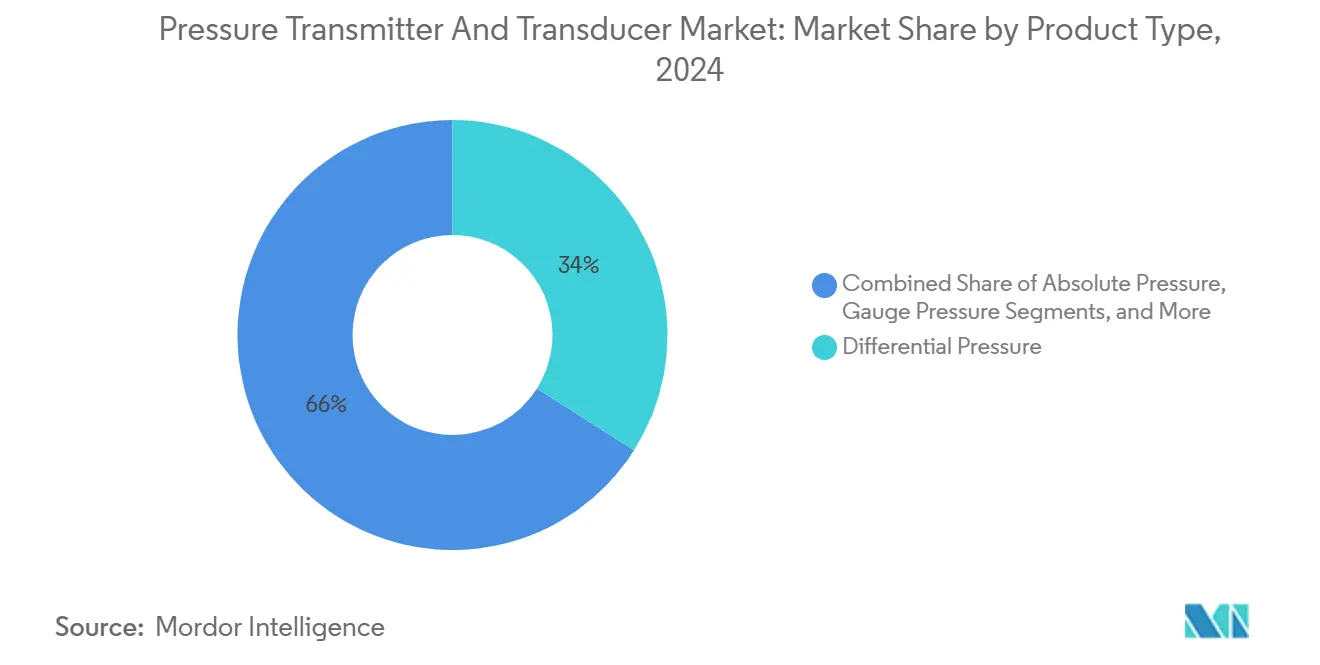
Note: Segment shares of all individual segments available upon report purchase
By Sensing Technology: Optical Sensors Disrupt Traditional Paradigms
Piezoresistive chips delivered 48% of 2024 revenue owing to low cost and robust temperature compensation. Optical solutions, however, are expanding at a 7.2% CAGR, immune to electromagnetic interference and ideal for harsh zones. NETL’s laser-grown optical fiber probes endure extreme heat with extended linearity.
Hybrid MEMS–optical assemblies are emerging to capture both low-pressure sensitivity and high-pressure resilience. As on-board photonics prices fall, the pressure transmitter and transducer market will gradually migrate upscale, particularly in nuclear power and high-frequency RF test stands that demand EMI immunity. [5]U.S. Department of Energy, “New Laser-Heated Pedestal Growth,” netl.doe.gov
By Pressure Range: Ultra-High Applications Drive Innovation
The medium band (100-1,000 psi) held a 45% share in 2024; nonetheless, ultra-high devices above 10,000 psi advance at a 6.4% CAGR. Glenair’s 10,000 psi SeaKing connectors with dual O-rings exemplify component hardening for subsea environs.
Advances in sapphire diaphragms and remote seal designs reduce hysteresis, widening use in supercritical CO₂ pipelines and isostatic metal forming. In lower-pressure niches, self-powered wireless sensors like PassiveLogic’s Sense Nano cut cabling and commissioning time, supporting smarter buildings. This fragmentation keeps the pressure transmitter and transducer market diversified.
By End-User Industry: Pharmaceutical Sector Emerges as Growth Engine
Oil and gas operations used 28% of shipments in 2024 to safeguard wells, separators, and pipelines. Cleanroom-intensive pharmaceuticals now post the fastest 6.5% CAGR as biologics scale. Positive-pressure rooms that keep sterility and negative suites containing potent compounds depend on tight differential control.
Equipment such as Siemens SITRANS P300, certified to EHEDG and 3-A, meets wash-down and explosion-proof needs simultaneously. Parallel momentum in water reclamation, food processing, and power generation sustains baseline demand, ensuring the pressure transmitter & transducer market remains broadly diversified across verticals. [4]Superior Sensor Technology, “Differential Pressure Monitoring and Clean Room Safety,” azom.com
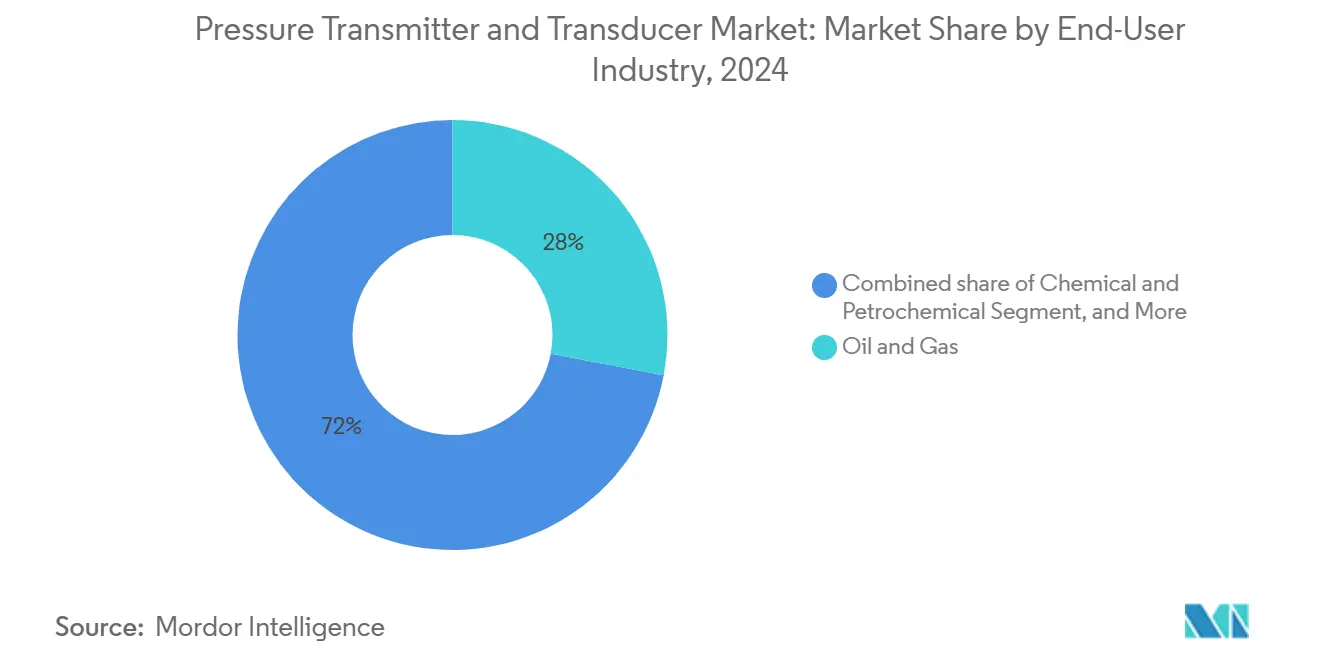
By Output/Communication: Wireless Protocols Reshape Connectivity
Analog 4-20 mA lines still deliver 52% of shipments, valued for noise immunity and universal PLC compatibility. Yet wireless nodes, growing at 8.1% CAGR, eliminate trenching costs in sprawling sites. WirelessHART meshes reroute signals automatically and secure packets via AES-128, achieving sub-100 ms latency in dense networks.
IO-Link adoption in food plants illustrates how single-pair wiring and automatic device IDs streamline maintenance. Such connectivity upgrades expand data granularity, reinforcing analytics-driven value within the pressure transmitter and transducer market.
Geography Analysis
Asia-Pacific generated 38% of global revenue in 2024, anchored by aggressive semiconductor capacity expansion. Foundries specify ultra-clean stainless-free assemblies, particularly in Taiwan and South Korea, reinforcing regional leadership within the pressure transmitter & transducer market. China’s shift toward higher-precision manufacturing keeps demand brisk for mid-range sensors in automotive and chemical plants. Japan sustains a premium niche for aerospace and robotics-grade instruments, while India’s vaccine plants boost cleanroom sensor uptake.
The Middle East leads growth at a 5.7% CAGR through 2030. Saudi Arabia’s Vision 2030 diversifies chemicals and hydrogen, elevating need for SIL-3 certified transmitters. SABIC’s USD 37.3 billion sales in 2024 fund low-carbon product rollouts reliant on advanced pressure control. The UAE’s localization drive is exemplified by Baker Hughes’ new Abu Dhabi facility, which trims lead times and heightens supply-chain resilience.
North America remains technologically forward, with shale operators adopting wireless transmitters for real-time well diagnostics. Federal incentives for carbon storage add specialized demand for high-integrity devices. Europe favors energy-efficiency retrofits and progressive safety norms, spurring purchases of smart, self-verifying transmitters for hydrogen clusters. South America’s deep-water campaigns in Brazil and Guyana mandate ultra-high pressure units, while mining projects across Chile and Peru secure rugged designs. Collectively, varied regional drivers sustain the pressure transmitter and transducer market’s balanced global footprint.
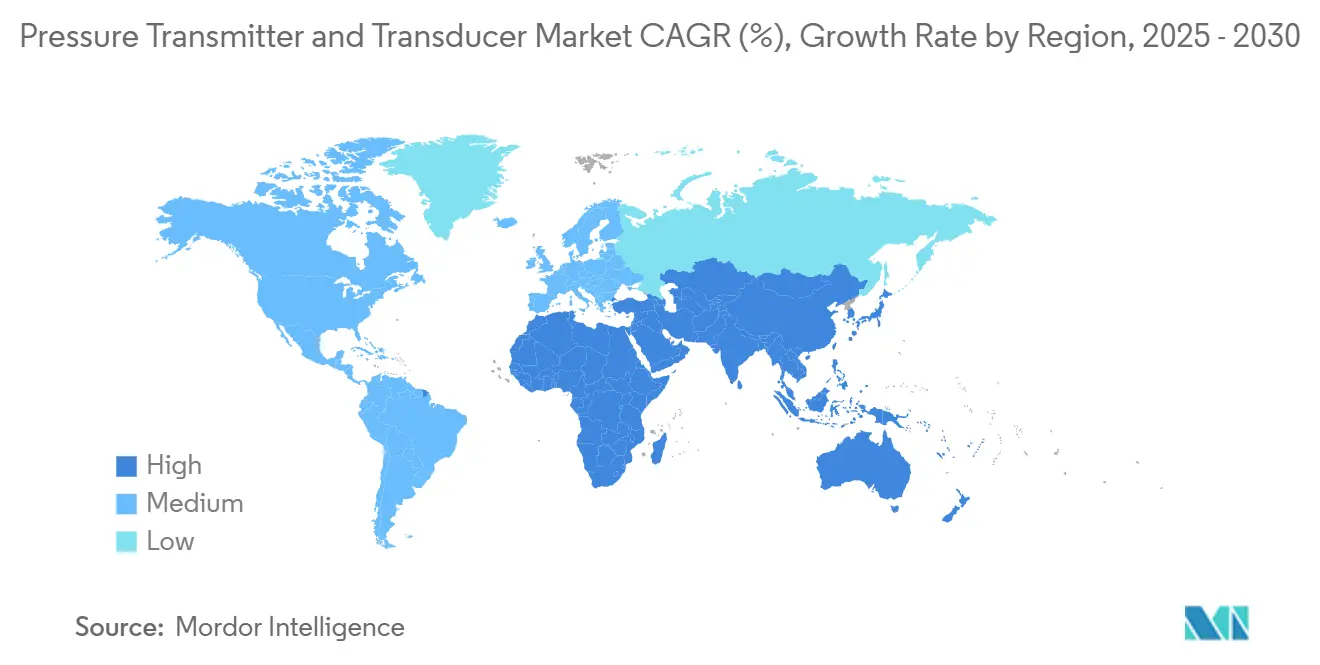
Competitive Landscape
The field blends diversified giants and agile specialists. Emerson, ABB, Yokogawa, Honeywell, and Siemens leverage broad automation portfolios to capture multi-plant rollouts. Emerson’s 2025 refresh of the Rosemount 3051S line delivers ±0.025% accuracy and SIL-3 capability, reinforcing its premium tier. At the same time, software layers that visualize diagnostics and feed AI-based maintenance models now dominate value propositions.
Mid-sized players—WIKA, Keller, and Micro Sensor—differentiate through rapid custom engineering. Micro Sensor’s double-diaphragm MDM7100 earned Best of Industry recognition for stability in corrosive media. Such accolades help niche brands penetrate OEM machinery markets.
Investment in R&D remains robust; Endress+Hauser spent EUR 275.6 million (7.4% of 2024 sales) and launched 81 new instruments, many with Eco-Design features. Partnerships also abound: Fibercore allied with DIMIONE to bundle interrogators and fiber-optic sensors for European customers. These collaborations accelerate specialty offerings, sustaining competitive churn and driving innovation in the pressure transmitter and transducer market.
Pressure Transmitter And Transducer Industry Leaders
-
Emerson Electric Co.
-
ABB Ltd
-
Yokogawa Electric Corporation
-
Honeywell International Inc.
-
Siemens AG
- *Disclaimer: Major Players sorted in no particular order
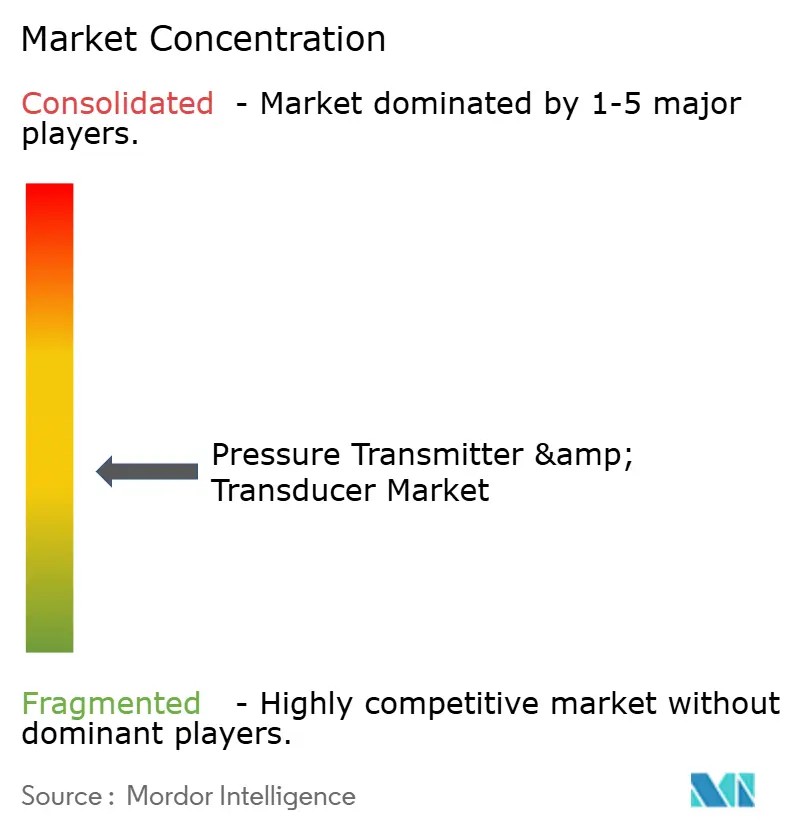
Recent Industry Developments
- May 2025: Endress+Hauser held its 2025 Innovators’ Meeting, celebrating employee innovations with a focus on sustainable product development and 701 patents granted.
- May 2025: Fibercore partnered with DIMIONE Systems to expand fiber-optic sensing solutions in France, Belgium, and Luxembourg.
- March 2025: Emerson launched the updated Rosemount 3051S platform, adding 200:1 turndown and multivariable models.
- November 2024: Baker Hughes inaugurated a surface pressure-control solutions center in Abu Dhabi to localize high-pressure equipment manufacturing.
Research Methodology Framework and Report Scope
Market Definitions and Key Coverage
Our study defines the pressure transmitter and transducer market as every factory-built electronic device that senses liquid or gas pressure, converts that signal into a proportional electrical output (4-20 mA, digital HART, Fieldbus, WirelessHART, IO-Link), and is shipped as a complete instrument ready for integration into process control, medical, or industrial equipment. The definition therefore covers differential, absolute, gauge, and multivariable transmitters together with strain-gauge, piezoresistive, capacitive, optical, and MEMS-based transducers across low to ultra-high ranges.
Scope Exclusion. Stand-alone mechanical Bourdon or diaphragm gauges and simple glass manometers that do not provide an electrical signal are excluded from sizing.
Segmentation Overview
- By Product Type
- Pressure Transmitters
- Differential Pressure
- Absolute Pressure
- Gauge Pressure
- Multivariable Pressure
- Pressure Transducers
- Strain-Gauge Transducers
- Piezoresistive Transducers
- Capacitive Transducers
- Optical Transducers
- Pressure Transmitters
- By Sensing Technology
- Piezoresistive
- Capacitive
- Strain Gauge
- Piezoelectric
- Optical
- MEMS Hybrid
- By Pressure Range
- Low (<100 psi / <7 bar)
- Medium (100-1000 psi)
- High (1 000-10 000 psi)
- Ultra-High (>10 000 psi)
- By Output / Communication
- Analog (4-20 mA, 0-10 V)
- Digital (HART, Fieldbus, Profibus, Modbus)
- Wireless (WirelessHART, ISA100)
- IO-Link
- By End-User Industry
- Oil and Gas
- Chemical and Petrochemical
- Power Generation and Utilities
- Water and Wastewater
- Food and Beverage
- Pharmaceuticals and Biotechnology
- Medical Devices and Healthcare
- Aerospace and Defense
- Semiconductor and Electronics
- Mining, Metals and Marine
- By Geography
- North America
- United States
- Canada
- Mexico
- Europe
- Germany
- United Kingdom
- France
- Italy
- Spain
- Nordic Countries (Sweden, Norway, Denmark)
- Asia-Pacific
- China
- Japan
- India
- South Korea
- Taiwan
- Southeast Asia (Indonesia, Malaysia, Thailand, Vietnam)
- Australia
- New Zealand
- South America
- Brazil
- Argentina
- Chile
- Middle East
- Saudi Arabia
- United Arab Emirates
- Qatar
- Turkey
- Africa
- South Africa
- Nigeria
- Egypt
- North America
Detailed Research Methodology and Data Validation
Primary Research
We validate secondary signals through structured interviews with instrumentation engineers, EPC procurement leads, and regional distributors in North America, Europe, Asia-Pacific, and the Middle East. The conversations clarify retrofit rates, wireless penetration, and discount structures, letting us close gaps and align milestone years.
Desk Research
Mordor analysts begin with tier-one public datasets from bodies such as the International Energy Agency, Eurostat industrial production, and UN Comtrade HS-902620 shipment codes, and then mine NAMUR and ISA bulletins for installed-base trends. Patent landscapes pulled through Questel, together with news feeds from Dow Jones Factiva, highlight technology shifts and project awards, while D&B Hoovers filings reveal revenue splits and typical selling prices. These sources build the volume and pricing lattice. They remain indicative only, and many further references are screened to refine each assumption.
Market-Sizing & Forecasting
A top-down model starts with process industry capital spending and trade data to reconstruct global demand, followed by sampled average selling prices multiplied across the installed base to check totals. Bottom-up cross checks use supplier revenue roll-ups and channel feedback before adjustments. Key inputs include refinery and chemical capacity additions, average transmitter replacement cycles, penetration of smart protocols, stainless-steel cost trends, and evolving safety mandates. A multivariate regression blends these drivers to forecast volume and value through 2030, with scenario analysis testing oil price or capex shocks.
Data Validation & Update Cycle
Outputs pass variance checks against historic ratios, peer benchmarks, and Volza import clusters; anomalies trigger a second analyst review. Reports refresh annually, and material events such as a major refinery sanction prompt interim updates. A final pre-release pass ensures clients receive the latest calibrated view.
Why Mordor's Pressure Transmitter & Transducer Baseline Earns Confidence
We acknowledge that published values diverge because each publisher chooses its own scope, pricing lens, and refresh rhythm. We recognize that clear visibility into those levers helps decision-makers trust a number.
Key gap drivers appear when other firms omit ultra-high pressure instruments, fold mechanical gauges into totals, or roll forward values using outdated exchange rates, whereas Mordor keeps a consistent electrical output scope, applies region-specific ASP deflators, and refreshes every twelve months.
Benchmark comparison
| Market Size | Anonymized source | Primary gap driver |
|---|---|---|
| USD 3.21 B (2025) | Mordor Intelligence | - |
| USD 3.11 B (2024) | Global Consultancy A | Excludes ultra-high pressure segment and uses 2020 exchange rates |
| USD 3.52 B (2024) | Trade Journal B | Combines mechanical gauges with electronic units and applies uniform ASP uplift |
These contrasts show that Mordor's disciplined scope selection, variable-level checks, and yearly refresh give stakeholders a balanced, transparent baseline that can be traced back to measurable indicators and repeated with limited resources.
Key Questions Answered in the Report
What is the current size of the pressure transmitter & transducer market?
The market is valued at USD 3.21 billion in 2025 and is forecast to reach USD 3.85 billion by 2030 at a 3.65% CAGR.
Which region holds the largest share of the pressure transmitter & transducer market?
Asia-Pacific leads with 38% share in 2024, driven by semiconductor and industrial expansion.
Which product segment is growing the fastest?
Multivariable transmitters are advancing at a 5.8% CAGR because they consolidate multiple measurements into one device, cutting installation costs.
Why are optical pressure sensors gaining popularity?
They resist electromagnetic interference and perform well in harsh or high-temperature environments, fueling a 7.2% CAGR through 2030.
How are wireless protocols impacting the pressure transmitter & transducer industry?
WirelessHART and similar networks reduce cabling costs and enable remote diagnostics, supporting the segment’s 8.1% CAGR.
What are the main restraints on market growth?
MEMS-chip failures in high-vibration down-hole conditions and aggressive price competition in 0-10 bar ranges are the most influential restraints.
Page last updated on:
